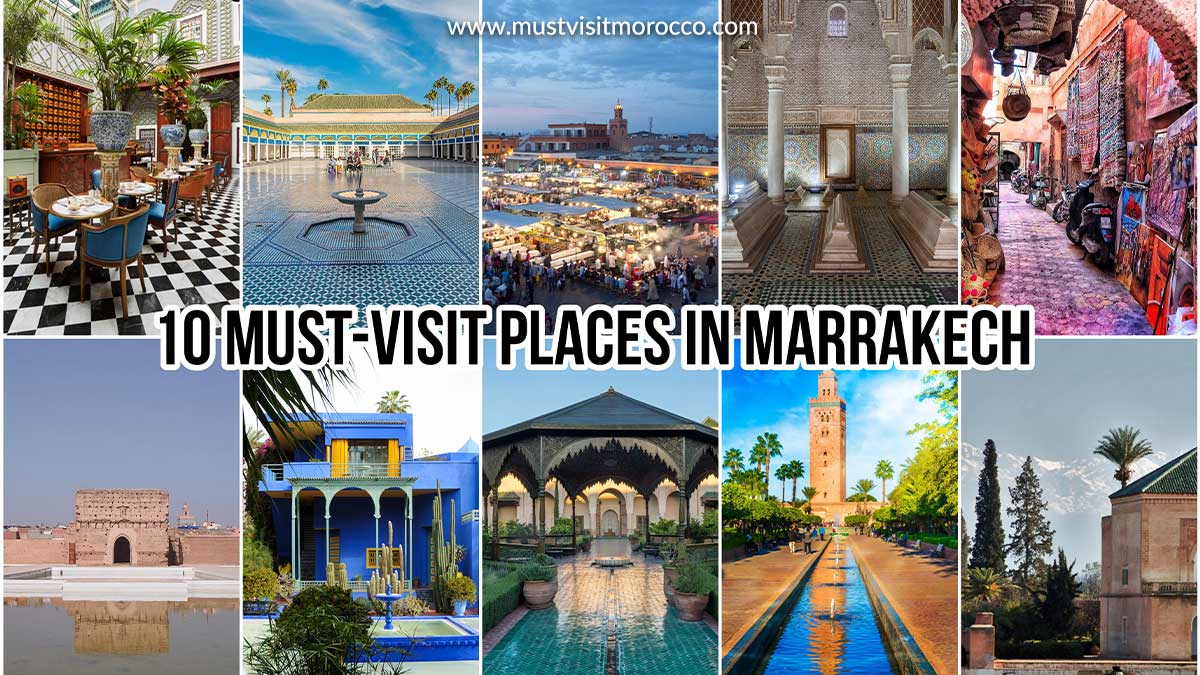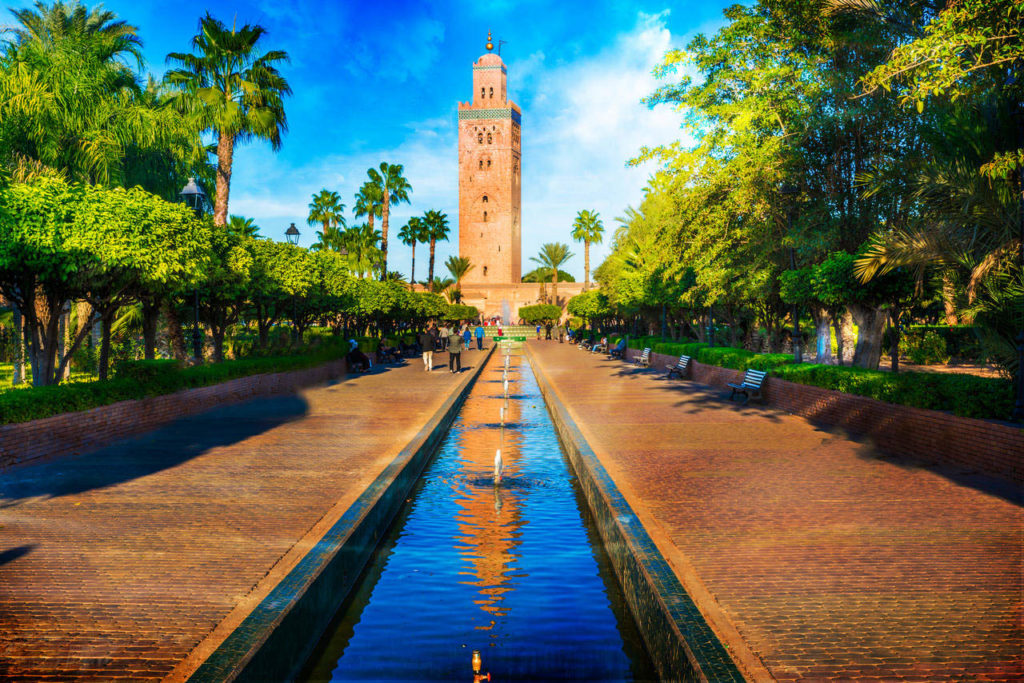
Marrakech, the Ochre City, pulsates with an intoxicating blend of ancient traditions and vibrant modern life. Nestled at the foot of the majestic Atlas Mountains, this imperial city in Morocco is a sensory overload, a labyrinth of bustling souks, fragrant spices, and echoes of a rich history. From its legendary Djemaa el-Fna square to the serene beauty of its gardens and palaces, Marrakech offers an unforgettable journey for every traveler.
A Glimpse into Marrakech’s Storied Past
Marrakech’s story began in the 11th century when it was founded by the Almoravids. It quickly rose to prominence as a powerful capital, a vital center for trade and Islamic scholarship. Over centuries, it witnessed the rise and fall of dynasties – the Almohads, Saadiens, and Alaouites – each leaving their indelible mark on the city’s architecture and cultural landscape. The Saadiens, in particular, are credited with many of the city’s most exquisite palaces and tombs.
Related Articles about Marrakech: A Tapestry of Spice, Souks, and Centuries:
- Unveiling the Majesty: Top Things to Do in the United Kingdom
- Amsterdam: Where Canals Whisper Histories and Luxury Hotels Bloom
- Stockholm’s Royal Embrace: A Guide to the City’s Top Hotels and Unforgettable Experiences
- Canada: A Grand Tapestry of Nature, Culture, and Adventure – Your Ultimate Travel Guide
- A Journey Through Paradise: Your Ultimate Travel Guide to the Philippines
The city’s strategic location along ancient trade routes made it a crucial hub connecting sub-Saharan Africa with the Mediterranean. This history of commerce and cultural exchange is still palpable today in the bustling souks, where artisans have plied their trades for generations. Marrakech has been a magnet for explorers, artists, and writers, drawn by its exotic allure and unique atmosphere. From the days of the caravan routes to its current status as a UNESCO World Heritage site, Marrakech has consistently captivated the world.
The Heartbeat of the City: Main Attractions
Marrakech’s magic lies in its ability to transport you through time, with each corner revealing a new wonder.
-
Djemaa el-Fna: This is not just a square; it’s a living, breathing spectacle. By day, it’s a bustling marketplace with snake charmers, storytellers, and juice vendors. As dusk descends, it transforms into an open-air culinary wonderland, with dozens of food stalls serving up delicious Moroccan delicacies. The air hums with the sound of music, laughter, and the sizzle of grills. Don’t miss the chance to experience the vibrant energy, watch the performers, and sample some local street food.
-
Koutoubia Mosque: Standing tall and proud, the Koutoubia Mosque is Marrakech’s most iconic landmark. Its magnificent minaret, a masterpiece of Almohad architecture, can be seen from miles around. While non-Muslims cannot enter the prayer hall, the exterior and its surrounding gardens offer a glimpse into its grandeur and a peaceful escape from the city’s hustle.
-
Bahia Palace: A testament to the opulence of the 19th century, the Bahia Palace is a sprawling complex of courtyards, gardens, and intricately decorated rooms. Built for the Grand Vizier Ba Ahmed, its name means "brilliance." Wander through its shaded courtyards, admire the stunning mosaics, carved stucco, and painted cedarwood ceilings. It offers a fascinating insight into the luxurious lifestyle of Moroccan aristocracy.
-
Saadian Tombs: Hidden for centuries, these beautifully preserved tombs were rediscovered in 1917. They are a stunning example of Moorish architecture, featuring intricate tilework, carved marble, and delicate stucco. The mausoleum of Sultan Ahmed al-Mansur and his family is particularly breathtaking.
-
Jardin Majorelle: A vibrant oasis of tranquility, the Jardin Majorelle is a botanical garden and artistic masterpiece created by French Orientalist painter Jacques Majorelle. It’s renowned for its striking cobalt blue accents, exotic plants, and tranquil fountains. After Majorelle’s death, it was bought and restored by Yves Saint Laurent and Pierre Bergé, who preserved its unique charm. The Berber Museum within the garden is also a must-visit.
-
Ben Youssef Madrasa: Once the largest Islamic college in North Africa, this architectural gem is a marvel of Andalusian design. Its intricate geometric patterns, carved stucco, and beautiful zellige tilework are awe-inspiring. The central courtyard with its reflecting pool offers a serene and photogenic setting.
-
The Souks: Prepare to get lost, in the best possible way, within Marrakech’s sprawling souks. These vibrant marketplaces are a maze of narrow alleyways, each dedicated to a specific craft. You’ll find everything from hand-woven carpets and leather goods to intricate lanterns, spices, and traditional clothing. Haggling is an integral part of the experience, so embrace it with a smile!
-
Mellah (Jewish Quarter): Explore the historic Jewish quarter, which offers a different perspective on Marrakech’s cultural tapestry. Discover its synagogue, traditional houses, and the lively market.
-
El Badi Palace: Though largely in ruins, El Badi Palace offers a sense of its former grandeur. Once a magnificent imperial palace, its vast courtyards and remnants of its elaborate decorations hint at the wealth and power of the Saadien dynasty. Climb to the ramparts for panoramic views of the city.
Navigating Marrakech: Essential Travel Tips
To make your Marrakech adventure seamless and enjoyable, keep these tips in mind:
- Currency: The Moroccan Dirham (MAD) is the official currency. It’s advisable to carry some cash, especially for souk purchases and smaller establishments, though credit cards are increasingly accepted in hotels and larger shops.
- Language: Arabic and Berber are the official languages. French is widely spoken due to historical ties, and English is understood in tourist areas. Learning a few basic Arabic phrases like "Salam Alaikum" (peace be upon you) and "Shukran" (thank you) will be appreciated.
- Dress Code: Marrakech is a relatively liberal city, but it’s important to dress respectfully, especially when visiting religious sites. Covering your shoulders and knees is generally recommended for both men and women.
- Haggling: Bargaining is an art form in the souks. Start with an offer significantly lower than the asking price and be prepared to walk away if you don’t reach a satisfactory agreement. Be polite and friendly throughout the process.
- Scams and Pickpockets: Like any bustling tourist destination, be aware of your surroundings. While most locals are friendly, be cautious of overly persistent touts or individuals offering unsolicited "help." Keep your valuables secure.
- Water: Drink bottled water only to avoid any stomach upset.
- Connectivity: Wi-Fi is readily available in most hotels and cafes. You can also purchase a local SIM card for affordable data.
- Respectful Photography: Always ask permission before taking photos of people, especially women and children.
- Tipping: Tipping is customary in Morocco. For services like restaurant staff, guides, and drivers, a tip of 10-15% is generally appreciated.
The Sweet Spot: Best Time to Visit Marrakech
Marrakech experiences a desert climate, with hot summers and mild winters.
- Spring (March to May): This is arguably the best time to visit. The weather is pleasant and warm, with average temperatures ranging from 20-28°C (68-82°F). The gardens are in full bloom, and the city is alive with activity.
- Autumn (September to November): Similar to spring, autumn offers comfortable temperatures and sunny days, making it ideal for exploring.
- Winter (December to February): Winters are mild and pleasant, with daytime temperatures averaging around 18-22°C (64-72°F). Evenings can be cool, so pack layers. This is a great time to visit if you prefer cooler weather and fewer crowds.
- Summer (June to August): Summers are intensely hot, with temperatures often soaring above 40°C (104°F). While you can still visit, be prepared for the heat and plan your outdoor activities for the cooler parts of the day.
A Haven for the Traveler: Nearby Hotels
Marrakech offers a diverse range of accommodation to suit every budget and preference, from opulent riads to modern hotels.
-
Luxury:
- La Mamounia: An iconic and legendary hotel, offering unparalleled luxury, stunning gardens, and world-class service.
- Royal Mansour Marrakech: A masterpiece of Moroccan craftsmanship, offering exquisitely designed private riads and exceptional hospitality.
- The Oberoi, Marrakech: Nestled amidst olive groves, this serene retreat offers spacious villas and a tranquil escape.
-
Mid-Range:
- Riad BE Marrakech: A beautiful and stylish riad with a central courtyard, rooftop terrace, and excellent service.
- Jnane Palace Marrakech: Offers comfortable rooms, a swimming pool, and a convenient location.
- Four Seasons Resort Marrakech: While a global brand, it offers a luxurious experience with Moroccan flair.
-
Budget-Friendly:
- Riad El Fna: Offers a charming and affordable stay within walking distance of Djemaa el-Fna.
- Hostel Riad Marrakech Rouge: A popular choice for backpackers, offering a social atmosphere and basic amenities.
- Numerous Riads: Many smaller, family-run riads offer excellent value for money and an authentic experience. Look for them slightly further from the main tourist hubs for better prices.
A Culinary Journey: Local Food to Savor
Marrakech is a gastronomic paradise, where flavors are bold and ingredients are fresh.
- Tagine: The quintessential Moroccan dish, a slow-cooked stew prepared in a conical clay pot. Popular varieties include lamb with prunes, chicken with lemon and olives, and vegetable tagine.
- Couscous: Traditionally served on Fridays, this fluffy semolina dish is often accompanied by a hearty vegetable and meat stew.
- Pastilla: A sweet and savory pie, typically made with pigeon or chicken, almonds, and spices, dusted with cinnamon and powdered sugar. It’s a unique and delicious experience.
- Harira: A rich and flavorful soup, often enjoyed during Ramadan, made with tomatoes, lentils, chickpeas, and spices.
- Mechoui: Slow-roasted lamb, incredibly tender and succulent, often found at street stalls in Djemaa el-Fna.
- Mint Tea: The national drink of Morocco, a sweet and refreshing green tea infused with fresh mint. It’s a symbol of hospitality and is offered everywhere.
- Moroccan Pastries: Indulge in an array of sweet treats like gazelle horns (almond-filled pastries), chebakia (honey-drenched sesame cookies), and other delectable delights.
- Street Food: Don’t shy away from the food stalls in Djemaa el-Fna. Sample grilled meats, snail soup (if you’re adventurous!), and freshly squeezed orange juice.
Getting Around: Transportation Options
Marrakech offers several convenient ways to explore the city and its surroundings:
- Walking: The best way to experience the Medina (old city) and its souks is on foot. Wear comfortable shoes as the streets can be uneven.
- Petit Taxis: These small, metered taxis are a convenient way to get around within the city. Always ensure the meter is used, or agree on a price beforehand if the meter isn’t functioning. They are typically red.
- Grand Taxis: These are larger taxis that operate on fixed routes, often between cities or to specific destinations outside the Medina. They are a more shared and economical option for longer distances.
- Horse-drawn Carriages (Caleches): A romantic and traditional way to see the city, especially for a tour around the ramparts or to specific landmarks. Negotiate the price before you set off.
- Buses: Local buses are available and are a very affordable way to travel, though they can be crowded and less comfortable for tourists.
- Rental Cars: While not recommended for navigating the Medina, renting a car can be useful for exploring areas outside of Marrakech, such as the Atlas Mountains. Be aware of the often chaotic driving styles.
- Airport Transfers: Taxis are readily available at Marrakech Menara Airport (RAK). You can also pre-book airport transfers through your hotel or a private service for a hassle-free arrival.
Marrakech is more than just a destination; it’s an experience that will linger long after you leave. It’s a city that awakens the senses, nourishes the soul, and invites you to lose yourself in its vibrant embrace. So, pack your bags, open your mind, and prepare to be enchanted by the magic of Marrakech.








